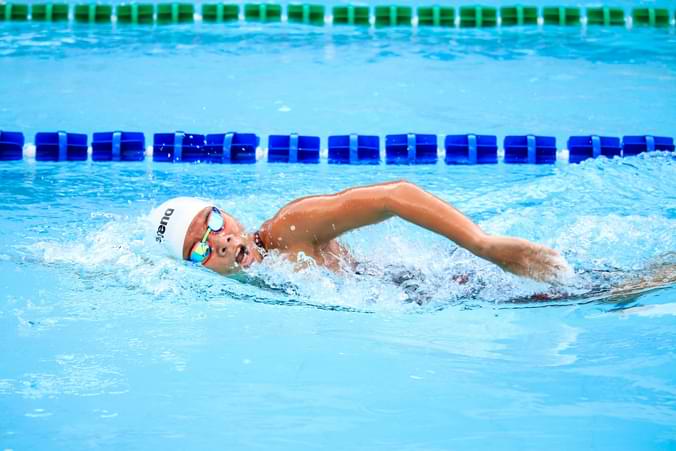Swimming is a fun and healthy activity that keeps your body fit and calms the mind. If you’re thinking of learning swimming or want to improve, this guide is for you. In simple language, we explain the basic aspects of swimming.
Why is Swimming Needed?
Swimming isn’t just a game; it has a positive impact on your health and many other aspects of life.
Mental and Physical Benefits
- The Whole Body Workout: This is an exercise that activates every part of your body.
- Reduces Stress: Spending time in water calms the mind and erases fatigue.
- Improve Fitness: It’s the best way to burn calories and control weight.
- Safety Skills: Learning swimming helps keep you safe in water.
- Useful for Every Age: Swimming is beneficial for people of all ages, especially for those troubled by joint or muscle pain.
What Preparations to Do Before You Start?
Choose the Right Gear
- Swimsuit: Choose a swimsuit that’s comfortable and fits perfectly.
- Goggles: Protect your eyes from water.
- Swim Cap: Keep your hair safe and dry.
- Floats and Kickboards: Useful tools for beginners.
Prepare Yourself for Water
- Warm-Up: Do light stretching before swimming.
- Be Comfortable in Water: Enter the water slowly and spend time relaxing.
- Stay Hydrated: Drink enough water before and after swimming.
Friendship with the Basics of Swimming
It’s essential to be comfortable with water at the beginning.
Learn to Float and Balance in Water
The Right Technique of Swimming
- Floating: Lay back on the surface of the water, breathe deeply, and stay relaxed.
- Breathing Technique: Exhale slowly while your head is in the water and take deep breaths when it’s out.
- Basic Strokes:
- Freestyle: Swim fast while maintaining the pace of your hands and legs.
- Breaststroke: Also called the ‘frog stroke,’ it’s comfortable and simple.
- Backstroke: Swimming on your back, which is beneficial for the spine.
Tips for Beginners
Select the Right Instructor
First-time learners should take the help of an experienced instructor.
Create Small Goals
- Master floating first.
- Gradually focus on strokes and distance.
Be Patient
Swimming is an art that improves over time with practice.
Be Aware of Safety
- Always swim under lifeguard supervision.
- Go to depths according to your ability.
- Avoid heavy meals before swimming.
Swimming with Friends
- Join a swimming group to stay motivated and enhance the fun.
- Take new challenges: Improve timing, try different strokes, and participate in competitions.
Common Problems and Solutions
- Feeling Afraid in Water: Practice slowly. Focus on floating and breathing techniques.
- Getting Tired Quickly: Swim at a comfortable speed and focus on proper strokes.
- Mistakes in Technique: Seek guidance from a professional instructor.
How to Improve Swimming?
- Do Regular Exercises: Practice swimming 3–4 times a week.
- Maintain Fitness: Strength training and yoga can enhance your swimming ability.
- Track Your Progress: Record your distance and timing.
What is the basic rule of swimming?
Safety First: Always prioritize safety while swimming. Never swim in deep water without assessing your ability first and always swim under the supervision of a lifeguard.
Breathing Technique: It’s very important to breathe correctly while swimming. Exhale when your head is in the water, and take a deep breath when you lift your head out of the water.
Balance and Floating: Start by learning how to balance and float in the water. This will help you feel confident and swim better.
Stroke Technique: Practice the correct stroke techniques. This will reduce the pressure on your body and allow you to swim longer. Learn the right way to do each stroke (like freestyle, breaststroke, backstroke).
Patience and Regular Practice: Swimming is a skill that improves with regular practice. Be patient and keep practising consistently.
These basic swimming rules will help you swim safely and give you an enjoyable experience.
Conclusion
Swimming is a fun, healthy, and lifelong skill. With the right gear, patience, and regular practice, you can become an efficient swimmer. So, step into the pool and start your friendship with water!
FAQs
- How long does it take to learn to swim?
It depends on your effort and practice. - Can people of all ages swim?
Yes, swimming is suitable for all ages. - Does swimming reduce weight?
Yes, it’s an excellent way to burn calories. - What are the things needed for swimming?
Swimsuits, goggles, swim caps, and beginner tools like kickboards. - Can I learn swimming in 1 month?
- Learning to swim in one month is an ambitious goal, but it’s possible with dedication and consistent practice. Here’s a structured plan to help you achieve your goal: Set Clear Goals: Determine what specific swimming skills you want to learn within the month.

1 thought on “The Basics Guide to Swimming”